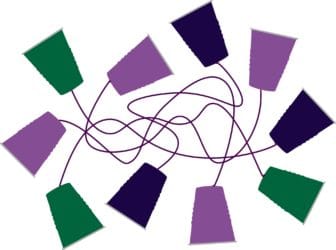I was recently reading an article from Psychology Today entitled, “Why Didn’t You Hear What I Meant to Say?” by Leon F Seltzer, Ph.D., where the author illustrates how people trick themselves into thinking that they’ve adequately communicated with others. As a Marketing Director and Agile Coach, I’ve experienced firsthand how people can fall into the trap of being inadvertently vague, wavering, or completely distracted to the point of inefficiency.
 Miscommunication can quickly derail any project. Knowledge Management projects are notoriously rife with miscommunication and confounded expectations. Like every knowledge project, KM can be broad and esoteric, with several different opinions and ideas around implementation. If we’re not careful, this can cause schedule delays and have financial implications. When these issues are not addressed until late in the schedule, each change’s cost can significantly increase because more time, money, and energy is invested in the project. Being a facilitator and an effective communicator amid a pandemic and universal work from home orders is even more challenging. You don’t always benefit from tonality or body language to help guide the conversation, but don’t despair. Utilizing Agile principles can help avoid the pitfalls of miscommunication, enhance visual communication, and encourage developing an environment of cohesion with your team. If you’re unsure how to do this on your own, Agile Coaches, like myself, are here to help you create a culture of productivity and successful communication.
Miscommunication can quickly derail any project. Knowledge Management projects are notoriously rife with miscommunication and confounded expectations. Like every knowledge project, KM can be broad and esoteric, with several different opinions and ideas around implementation. If we’re not careful, this can cause schedule delays and have financial implications. When these issues are not addressed until late in the schedule, each change’s cost can significantly increase because more time, money, and energy is invested in the project. Being a facilitator and an effective communicator amid a pandemic and universal work from home orders is even more challenging. You don’t always benefit from tonality or body language to help guide the conversation, but don’t despair. Utilizing Agile principles can help avoid the pitfalls of miscommunication, enhance visual communication, and encourage developing an environment of cohesion with your team. If you’re unsure how to do this on your own, Agile Coaches, like myself, are here to help you create a culture of productivity and successful communication.
Identify the Pitfalls
Let’s face it, communication challenges in our personal and professional lives existed long before COVID-19. Some people are better at expressing themselves than others, but typically our minds are focused on so many things at one time it can be challenging to hold our attention. Have you ever heard the phrase, “live your truth?” There’s a lot of validity to the term “your truth.” Depending on our experience, mood, intrusive thoughts, etc. we can all be in the same meeting and leave with a completely different understanding of the outcome. Some common pitfalls of miscommunication include:
- Inwardly “playing out” a conversation in our head and even writing our own narrative around other people’s thoughts and feelings;
- Telling someone else what we think, so we assume it’s already “out there,” even though it’s been communicated with the wrong person;
- Seeing only our portion of reality and discounting everyone else’s account of the truth; and
- Using vague terms or only expressing thoughts rather than providing feelings and examples.
So how do we stop ourselves and others from falling into the trap?
Stimulate Visual Communication
The first step to improving communication with others is believing that people generally have good intentions. The next is to be proactive and promote a community of transparency and effective communication. A core principle of Agility is that face-to-face conversation is the best form of communication; however, due to the pandemic, in-person meetings are typically not feasible. Don’t be afraid to reinforce the importance of face-to-face contact with your team by promoting video conferencing. However, be aware of the significant missing factor in video calls, non-verbal cues. For example, hearing nervous foot-tapping and watching exaggerated hand gestures can gauge interest, clarity, and rapport. That’s why active listening and empathizing with the speaker to understand what they’re saying is crucial when working remotely. Try paraphrasing in detail to confirm that you understand and clarify the definition of vague terms and idioms. Even when you’re speaking to people in the same language, the meaning of certain words or phrases can be different than our interpretation based on individual experiences. That’s why it never hurts to clarify.
Another solution to promote transparency and knowledge sharing is to maintain electronic task boards and wireframes. The team and external stakeholders benefit from this shared reference point that captures their ideas and vision. Solutions like MURAL, Trello, and JIRA have built-in collaboration templates allowing you to quickly and easily work together, even while remote. Most of these platforms enable team members to mention others and ask clarifying questions right in the application so that communications can extend beyond a meeting or event. This chatter and brainstorming are then captured in a centralized location rather than buried in email threads or one-off conversations with individuals.
Develop Understanding and Cohesion
No matter if you’re a stakeholder, product owner, or development team member, be persistent; communicate your feelings openly, honestly, and responsibly using descriptive words clearly expressing how you feel. When designing products or marketing campaigns, the phrases that leave me feeling the most frustrated and uninspired include:
“I wish it were cooler (or sexier, or had more pizazz).”
“I don’t like it. It’s bad.”
The unenthusiastic “looks good.”
“Looks good, given the time constraints (or another excuse).”
“It is what it is.”
After a dramatic internal eye-roll, I have to dig deep and go into my standard line of questioning to get to the root of what my customer or teammate is struggling to tell me. Finding that common ground and clarifying the meaning behind the initial vague feedback is crucial to save the team from several laborious changes.
 Wishy-washy language and lack of clarity can quickly deviate a project where the stakeholders’ vision drives requirements. In Agile, this gap between what is said and what is delivered is called the Gulf of Evaluation. Bridge the Gulf of Evaluation by getting your team to agree to a standard Definition of Done. The Definition of Done is a set of criteria achieved before a product increment can be considered complete. Another way to think of this outside of product development is to have your team agree upon a set of goals before starting the ideation process. This agreement provides a checklist that guides pre-implementation activities like discussion, prioritization, and design.
Wishy-washy language and lack of clarity can quickly deviate a project where the stakeholders’ vision drives requirements. In Agile, this gap between what is said and what is delivered is called the Gulf of Evaluation. Bridge the Gulf of Evaluation by getting your team to agree to a standard Definition of Done. The Definition of Done is a set of criteria achieved before a product increment can be considered complete. Another way to think of this outside of product development is to have your team agree upon a set of goals before starting the ideation process. This agreement provides a checklist that guides pre-implementation activities like discussion, prioritization, and design.
Encourage people to ask “why” to reveal the problem and derive a solution. An integral part of the Lean-Agile philosophy is the 5 Whys method developed by Sakichi Toyoda, a Japanese inventor and founder of Toyota Industries Co. The 5 Why’s is an iterative interrogative process in which you can peel away the onion layers by repeatedly asking “why.” When applying the 5 Why’s technique, you may find that your problem’s source is very unexpected. For example, you may think that you have a technical problem, but in reality there’s a problem with your people or processes. The same philosophy can be applied to understand someone’s thinking process and get to the root of their feelings about a particular issue.
Be the Change
When one person changes in the system, the system has to change, so lead by example and champion effective communication practices within your team. By communicating constructively, you can deliver greater value to your customers on time and within budget. If you need additional guidance, contact us. Our skilled facilitators and experienced agilists are here to lead and facilitate Agile adoptions big and small and to help you build effective Agile practices for your development teams.
